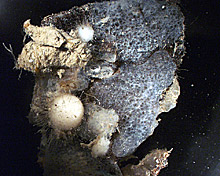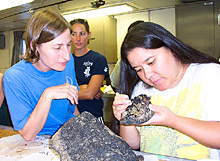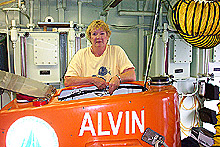
A push core being inserted in the sediment using Alvin’s manipulator arm. Photo by WHOI. Click image for larger view.
Alvin’s First Window Check
July 25, 2003
Taconya Piper, Web Coordinator
NOAA Office of Ocean Exploration
Slideshow of Alvin recovery from dive 3909
The first Alvin dive of the Windows to the Deep mission, number 3908, was a good example of true exploration. This was the first dive ever to occur along the northeastern eroded flank (side) of the Blake Ridge. In this exploratory effort, the observers spent the first few hours of the dive looking for older exposed rocks, methane seeps, and chemosynthetic communities in the area. Push core samples collected from the seafloor will be shared among several investigators for dating of the sediments and analysis of pore water geochemistry. Dr. W. Steven Holbrook, the lead scientific observers in the sub, described the site as “very muddy with fields of rocks that may be carbonate.” After resurfacing, Alvin pilot Phil Forte and observers Steven Holbrook and Bill Gilhooly, who both experienced their first Alvin dive, were properly welcomed back on board with the traditional ice water christening. >

A sponge encrusted rock collected at the Blake Ridge erosional surface as seen through a dissecting microscope. There were at least three to four different species of sponge found on this rock, and the spicules of some can be seen in this image. Photo by J. Dreyer. Click image for larger view.
Once Alvin and the observers were safely on deck, the sediment cores and rocks that were collected were removed from the Alvin basket, and scientists immediately began cataloging and processing the samples.
The two rocks collected along the dive transect were cleaned and dried, while the push cores were taken to the cold room for processing. Compared to sediments collected at other marine sites characterized by high microbial activity, the sediments recovered in these push cores had relatively high oxygen concentrations, indicative of low microbial loads. Several members of the science team worked into the early hours of the morning dividing and processing sediments for dating using microfossils, and for pore water chemistry studies.

Chief Scientist Dr. Carolyn Ruppel and graduate student Jennifer Dreyer examining a rock collected from approximately 3400 m water depth. Various sponge species were adhering to the rock when it was recovered. Photo by M. Olsen. Click image for larger view.
During the first dive, the co-chief scientists made a decision to conduct the second dive on the Blake Ridge Diapir, a known methane seep characterized by chemosynthetic communities and hydrate occurrences close to the seafloor. The science party looks forward to at least two days of dives at a site with such interesting geology, biology, and geochemistry.>
Stay tuned for more exciting information on Windows to the Deep and upcoming Alvin dives!
Margaret? Just What Are You Doing On This Ship Anyway?
Margaret Olsen
SouthEast Center for Ocean Science Education Excellence (SECOSEE)
Education Specialist
“For kids to truly learn something, they must see, touch, feel, and experience it.”
Paula Keener-Chavis suggested to the Co-Chief Scientist, Dr. Carolyn Ruppel, that I represent SECOSEE (SouthEast Center for Ocean Science Education Excellence) and be an ambassador for Outreach and Education during this mission. My official duties are to answer any “Ask A Scientist” questions that come in during the mission, as well as any follow-up questions by students, teachers or the general public once the mission is complete. I also assist with photodocumentation of science activities and interviewing members of the science party and the Atlantis’ crew.

Educator Specialist Margaret Olsen on top of the DSV Alvin. Although Margaret did not get to be an observer on a dive in this mission she was able to get in the submersible and experience what it is like in the sub while Alvin was in the hanger after a dive. Photo courtesy of M. Olsen. Click image for larger view.
The day after the ship left port from Woods Hole, I had the task of taking pictures and names of all of the science team members and the entire Atlantis crew for a two-page flyer that is posted on the bridge and several notice boards throughout the ship. These images are a great icebreaking tool as the ship’s crew slowly gets to know the new scientists on board (and vice versa).
I was charged by NOAA’s Office of Ocean Exploration and SECOSEE to prepare several presentations about “Life At Sea.” This presentation will be a summary (largely through photographs) of what an invited educator should expect when on a research cruise. I will include tips on what to expect, what to bring and what not to bring, the type of clothing one should pack, and how to prepare for any duties that may be assigned. I have also been given the task of conducting interviews and taking pictures of various members of the science party and the ship’s crew for the NASA Ocean Age website. Through these interviews and photographs, we will be able to relay information to K-12 students about scientific exploration, careers in marine science, and life as a mariner. Along with the interviews and photographs, I will include information about their backgrounds and their many achievements. I will also be collecting my share of clam shells, mussel shells, seafloor sediment, fish scales, rocks, and anything else the scientists will allow to me collect to share with teachers and students when I return to SECOSEE.
Post mission, I will submit articles about this cruise to the Skidaway Marine Institute quarterly magazine, the Georgia Science Teachers Association, the Georgia Marine Educators Association and possibly any other organizations that fall into the realm of SECOSEE (SECOSEE covers the states of North Carolina, South Carolina, and Georgia). I will also give a presentation at various SECOSEE “Ocean Awareness Days”.
It is such a joy to see a group of people work together as well as the crew of the RV Atlantis does. This experience has been truly awesome. Although I was unable to dive in the Alvin, I was given the opportunity to go inside and experience what it feels like to be an “Alvinaut”. I have met some incredible people (crew and scientists) and have a much deeper appreciation for the hard work and dedication it takes to become a research scientist. The Atlantis and Alvin group are incredible. They make the process of launching and recovering the Alvin appear as simple as a well rehearsed dance routine, and yet it is a massive undertaking.


















